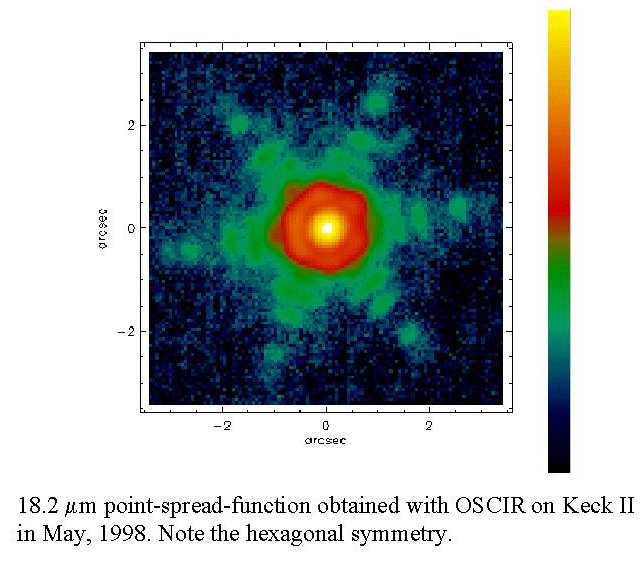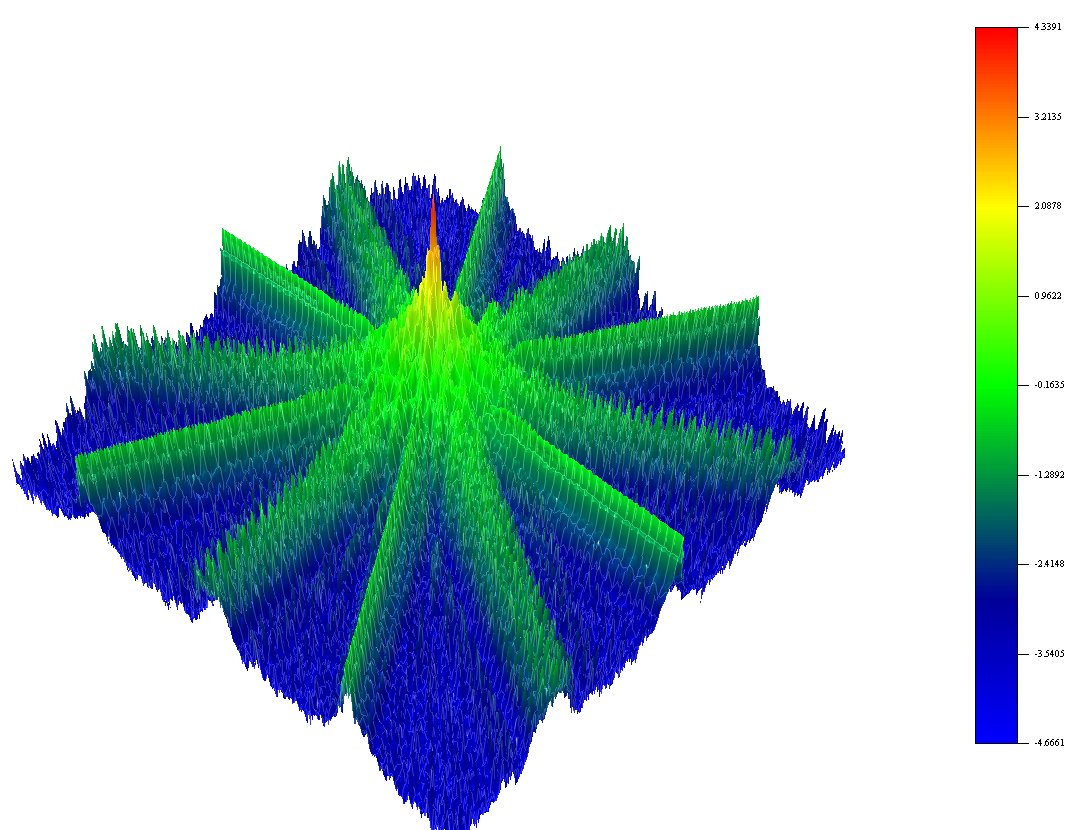
The observed PSF of
OSCIR on Keck, measured at 18.2 microns. Image: University of Florida Astronomy
Group.
Technical description
The basic imaging mode
can be adapted to coronagraphy by the insertion of an occulting spot in
the telescope focal plane (i0) and one of several Lyot stops in the pupil
plane p1. The occulting spot at i0 blocks the PSF core of the bright central
star or other celestial object. This spot may be sharp-edged or apodized,
and several sizes will be available. Although a variety of coronagraphic
Lyot stops will be available at p1, the primary Lyot stop there is currently
envisioned to consist of three parts: an inner hexagonal spot that blocks
the image of the secondary obscuration, a serrated outer mask that matches
the shape of the pupil edge but is undersized by about 10%, and a mask
that blocks the secondary-mirror spiders and possibly the primary-mirror
segment gaps. It is anticipated that the Lyot mask will rotate with the
rotating pupil image (this rotation is inherent in the alt-az telescope
design). The coronagraphy mode is baselined for use in the 10 micron window
only, but during the detailed design phase the IT will examine the use
of this mode in the 20 micron window.
Why Mid-infrared Coronagraphy?
There are several reasons why coronagraphy is interesting. At first sight, with the high level of the infrared background it may appear that coronagraphy is far less interesting than in the visible where the sky is dark and the faint extended diffraction pattern of a star can be detected out to a large distance. One extremely important reason is the form of the diffraction pattern as shown below in an OSCIR image of a star with Keck.

The observed PSF of
OSCIR on Keck, measured at 18.2 microns. Image: University of Florida Astronomy
Group.
We see two important features of the PSF. First, it has hexagonal symmetry because the Keck mirror, like the GTC's is made of hexagonal segments that combine to give an approximately hexagonal overall shape. This you see in the following figures that show the mirror shape and its pupil function.
The shape of the GTC
primary mirror showing the geometry of the segments and secondary
support (conceptual
only) that contribute to the PSF. Image: Grantecan SA.
Also, the spider that supports the secondary mirror has 6 arms (the diagonal lines crossing the mirror in the upper figure), giving long diffraction spikes. Note that at 18.2 microns, with a diffraction limit of 0.5 arcseconds, the spikes give structure out to at least 4 arcseconds (8 times the radius of the PSF). Any faint astronomical source that coincides with one of the diffraction spikes will be difficult or impossible to detect. The predicted GTC diffraction pattern (below) shows complex structure.
The calculated diffraction pattern from the GTC mirror and secondary support. Image: Christ Ftaclas.
On a logarithmic intensity scale we see just how far out from the image core significant energy can be found in the diffraction pattern.

The calculated diffraction
pattern from the GTC mirror and secondary support represented on a logarithmic
scale.
Significant power
extends out to many times the width of the PSF. Image: Christ Ftclas.
There is also a significant extended halo well beyond the central core of the PSF that will make the detection of faint companions difficult.
The aim of coronagraphy is twofold: to reduce the contribution of the diffraction spikes and to reduce the amount of power in the extended halo. By doing this we make it significantly easier to detect faint sources such as brown dwarfs and planets close to bright stars and also extended sources such as protoplanetary disks.
Performance
It is anticipated that, at a field angle of 1 arcsec, there will be a halo suppression of at least one order of magnitude during the best atmospheric conditions. In addition, this suppression will be achieved with a throughput loss due to the pupil masks that is no greater than 30%.
As illustrated below, modelling of the telescope and atmosphere show that the intensity of the extended halo of a source can be greatly reduced by using the coronagraphic mode on CanariCam.
The calculated azimuthally averaged intensity before supression (purple) and after (blue = circular Lyot stop; red = shaped Lyot stop). A factor of an order of magnitude supression is attained in this model, making the detection of faint sources (eg: extrasolar planets and brown dwarfs) considerably easier than before supression of the diffraction pattern. Image: Christ Ftclas.
At the present moment (pre-CDR) the performance of the coronagraphic option can be summarised as follows: